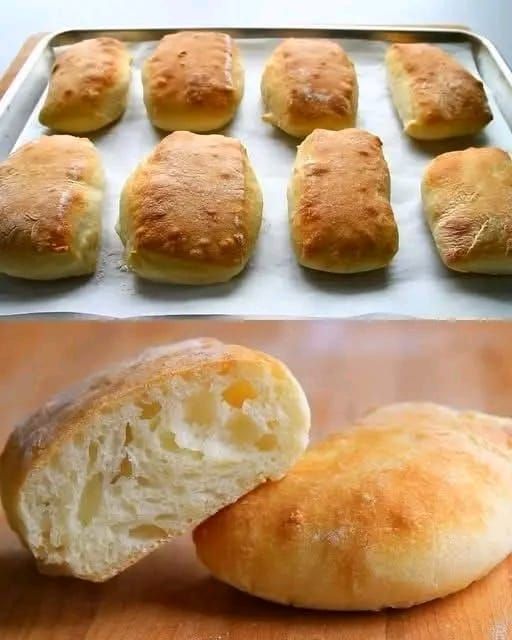Simple & Affordable Homemade Ciabatta Bread – Crispy, Light, and Incredibly Delicious! 🥖💛
October 8, 2025 by admin
Craving artisan bread without the artisan price tag? Look no further. This simple and affordable ciabatta bread recipe delivers everything you love about bakery-fresh bread: a crispy golden crust, a light and airy interior, and the delicate flavor of olive oil—all made in the comfort of your home with minimal ingredients.
Whether you’re a seasoned baker or a first-timer, this ciabatta recipe is easy to follow, extremely budget-friendly, and absolutely satisfying.
Why You’ll Love This Homemade Ciabatta Bread
- 🥖 Crunchy on the outside, soft on the inside
- 🧂 Made with just a few pantry staples
- 💰 Inexpensive and better than store-bought
- 🧄 Customizable with herbs, garlic, or olives
- 🍽️ Perfect for sandwiches, soups, or dipping
Ingredients You’ll Need
- 375 to 400 ml warm water
Lukewarm water (not hot) helps activate the yeast without killing it. - 1 packet (7g) active dry yeast
You can also use instant yeast—see FAQs below for alternatives. - 500g (about 3 ½ cups) bread flour
Bread flour has higher protein content, which gives the dough strength and stretch. - 1 ½ teaspoons salt
Enhances the flavor of the bread. - 1 tablespoon olive oil
Adds richness and promotes a tender crumb.
Step-by-Step Instructions
1. Activate the Yeast
- In a small bowl, mix the yeast into 100 ml of the warm water.
- Let it sit for 5–10 minutes until it begins to bubble and foam. This means the yeast is active and ready to work.
2. Make the Dough
- In a large mixing bowl, combine the bread flour and salt.
- Add the yeast mixture, the remaining water, and olive oil.
- Mix until a sticky, shaggy dough forms. If it seems too dry, add a little more water, one tablespoon at a time.
3. First Rise (Bulk Fermentation)
- Cover the bowl with a clean kitchen towel or plastic wrap.
- Let it rise in a warm area for 1 to 2 hours, or until the dough has doubled in size.
4. Shape the Dough
- Preheat your oven to 220°C (430°F).
- Lightly flour a flat surface and gently transfer the dough onto it.
- Without kneading too much, fold the dough a few times into a rough rectangle. Be gentle to keep air bubbles inside the dough.
- Place it on a baking sheet lined with parchment paper or a floured tea towel.
- Cover loosely and let it rest for 30 minutes for the second rise.
5. Bake to Perfection
- Place the baking sheet in the oven and bake for 20–25 minutes, or until the bread is golden brown and sounds hollow when tapped.
- For a crispier crust, add a small oven-safe pan of water to the bottom rack during baking to create steam.
6. Cool and Serve
- Remove from the oven and place on a wire rack to cool completely before slicing.
- Serve and enjoy!
Serving Suggestions
✨ This ciabatta bread is incredibly versatile. Try it:
- With olive oil and balsamic vinegar for dipping
- As a base for gourmet sandwiches or paninis
- Alongside soups and salads for a hearty meal
- Toasted with butter, garlic, or cheese
Baking Tips
- Always use lukewarm water to activate yeast (around 38°C / 100°F). Hot water can kill the yeast.
- Don’t over-handle the dough when shaping—gentle folds keep the bread light and airy.
- Use bread flour for best results. It has more protein, which helps form that stretchy, bubbly dough.
Nutritional & Health Notes
- Vegetarian & Vegan-Friendly: This bread contains no animal products, making it suitable for both diets.
- Olive oil is rich in heart-healthy monounsaturated fats.
- Bread flour provides extra protein for stronger gluten structure and better texture.
How to Store Ciabatta Bread
- Room Temperature: Store in an airtight container or wrap in a clean towel for up to 2 days.
- Freezer: Wrap tightly in plastic wrap and freeze for up to 1 month. Thaw and reheat in the oven for a crisp crust.
- Reheating Tip: To restore crispiness, reheat bread in a 350°F (175°C) oven for 5–10 minutes.
Frequently Asked Questions
Can I use all-purpose flour instead of bread flour?
Yes, though bread flour gives a chewier texture. All-purpose flour will still produce good results.
What if my dough is too sticky?
Sticky dough is normal for ciabatta. Lightly flour your surface and hands to handle it, but avoid adding too much flour—it will alter the texture.
Can I let the dough rise overnight?
Yes! Refrigerate the dough overnight, then bring to room temperature before shaping and baking.
Do I need a special pan?
No special pan is required. A regular baking sheet with parchment paper works perfectly.
Can I add herbs or flavorings?
Absolutely! Add rosemary, thyme, chopped olives, or roasted garlic into the dough before the first rise.
How do I know it’s baked through?
The crust should be deep golden and sound hollow when tapped. Internal temp should be around 90°C (195°F).
Can I double the recipe?
Yes. Just double all ingredients and divide the dough into two loaves before the second rise.
Can I use a bread machine?
Yes. Use the dough setting on your bread machine, then shape and bake according to the instructions above.
Final Thoughts – The Perfect Homemade Ciabatta
This simple ciabatta bread recipe proves that you don’t need fancy ingredients or equipment to make artisan-quality bread at home. With a bit of time and care, you’ll enjoy a loaf that’s light, crispy, full of flavor, and just as satisfying as anything from a bakery.
Perfect on its own or as part of your favorite meal, this bread will quickly become a staple in your kitchen.
Happy baking! 💖
